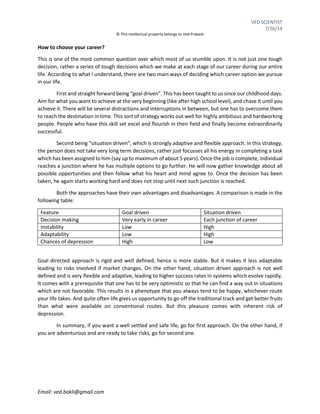More Related Content
Similar to how to choose your career (20)
how to choose your career
- 1. VED SCIENTIST
7/26/14
© This intellectual property belongs to Ved Prakash
Email: ved.bakli@gmail.com
How to choose your career?
This is one of the most common question over which most of us stumble upon. It is not just one tough
decision, rather a series of tough decisions which we make at each stage of our career during our entire
life. According to what I understand, there are two main ways of deciding which career option we pursue
in our life.
First and straight forward being “goal driven”. This has been taught to us since our childhood days.
Aim for what you want to achieve at the very beginning (like after high school level), and chase it until you
achieve it. There will be several distractions and interruptions in between, but one has to overcome them
to reach the destination in time. This sort of strategy works out well for highly ambitious and hardworking
people. People who have this skill set excel and flourish in their field and finally become extraordinarily
successful.
Second being “situation driven”, which is strongly adaptive and flexible approach. In this strategy,
the person does not take very long term decisions, rather just focusses all his energy in completing a task
which has been assigned to him (say up to maximum of about 5 years). Once the job is complete, individual
reaches a junction where he has multiple options to go further. He will now gather knowledge about all
possible opportunities and then follow what his heart and mind agree to. Once the decision has been
taken, he again starts working hard and does not stop until next such junction is reached.
Both the approaches have their own advantages and disadvantages. A comparison is made in the
following table:
Feature Goal driven Situation driven
Decision making Very early in career Each junction of career
Instability Low High
Adaptability Low High
Chances of depression High Low
Goal directed approach is rigid and well defined, hence is more stable. But it makes it less adaptable
leading to risks involved if market changes. On the other hand, situation driven approach is not well
defined and is very flexible and adaptive, leading to higher success rates in systems which evolve rapidly.
It comes with a prerequisite that one has to be very optimistic so that he can find a way out in situations
which are not favorable. This results in a phenotype that you always tend to be happy, whichever route
your life takes. And quite often life gives us opportunity to go off the traditional track and get better fruits
than what were available on conventional routes. But this pleasure comes with inherent risk of
depression.
In summary, if you want a well settled and safe life, go for first approach. On the other hand, if
you are adventurous and are ready to take risks, go for second one.

